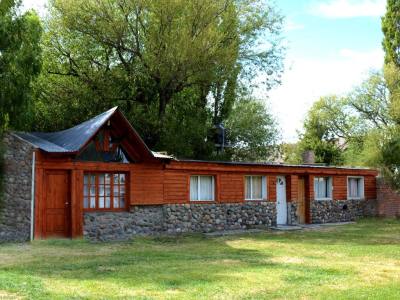
Sheep shearing and breaking in horses are known to be the hardest tasks. Each rural worker and each estancia is encouraged by its supporters, an essential part of the celebration.
When we arrived in
Río Mayo, it was bustling with activity. The National Shearing Fair attracts numerous people, on trucks or on horseback, some wearing their typical dress and a feeling of excitement pervaded the air. The venue was easy to spot because of the music, the voices and the typical smoke from the
asadores (spits). Neighbors flocked to the site, as did people like us, not country folk, but eager to take part anyway. We encountered a community who spends 365 difficult days a year either raising or shearing sheep paying homage to the first settlers who came to the area with a small flock as their only luggage. It is said that in those days they would make a yearly trip to
Comodoro Rivadavia to sell their wool and buy supplies. Whole families lived far from the cities and strove against all odds, harsh weather and loneliness to build a future for themselves and their offspring. As we heard: ‘Our backs bent by the effort, we faced snow, wind and water; we brought in the rams at the precise time, we hoped a late snowfall would not kill the lambs. We clipped eyes, we marked, we cut off tails and after all that, shearing time. It is the moment to harvest, to be paid for our sacrifice throughout the year. That is why we have this celebration.’

Patagonian Registered Trademark
Every significant moment during the three day celebration taught us the symbolism of the activity: the fleece, the blade shears, the comb and the yarn. One of the greatest surprises was that besides sheep,
guanacos are sheared, too. We witnessed a demonstration to get the thin thread with which such fine clothing is made. A cloud of dust announced the approach of the
gaucho groups dressed in Sunday best for the occasion. The young girls with their baby faces and slender bodies anxiously awaiting the jury’s decision to name the National Queen and Miss Fleece. We tasted the popular Patagonian lamb. Slices were cut directly from the spit. We savored it in the same simple fashion, discarding plates in favor of bread and a knife. During the shearing competition the famous blade shears danced in expert hands. Dexterity and speed in every competitor although, of course, there was only one winner. Several women proved to be just as good as the men. All those who had taken part were proud whether they had used the old blade shears or the new machine with combs, a technique which has benefited both the animal and the wool and brought better prices on the market. It would not have been a celebration without the
jineteada (staying on the back of an untamed horse) with its
grupa y bastos con encimera (different saddle apparels). The contestants eyed each other out, discussed the herds brought for the occasion dressed in their finest
gaucho clothes. The
payadores (folksingers) with their improvised songs added color to the show, at times encouraging the contestants and at times making us all smile with their mischievous verses. Renowned local and national artists performed on stage, and we found ourselves inadvertently joining in the dance. The celebration lasted until dawn. It was good to know that our traditions remain intact. As long as customs are passed on from generation to generation their values will live on and we will be able to show them to the world. An enthusiastic host, Río Mayo celebrated a hard year’s work ‘country style’ and shared it with its visitors.














